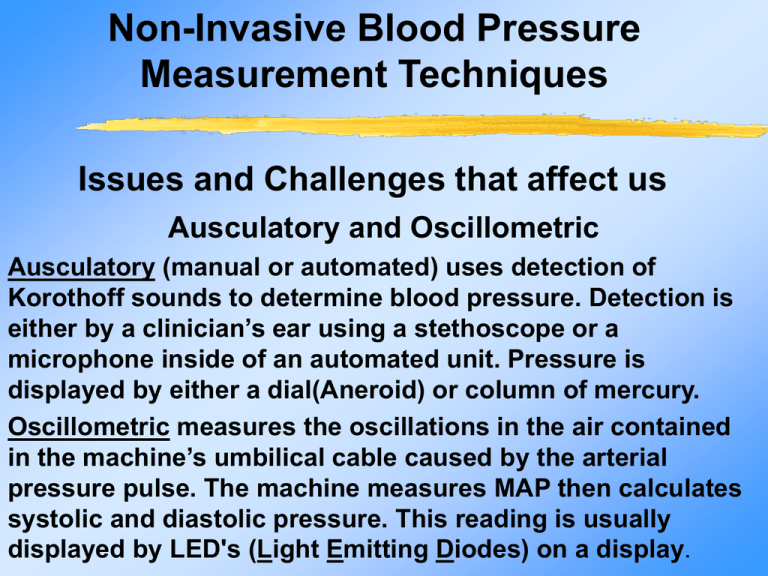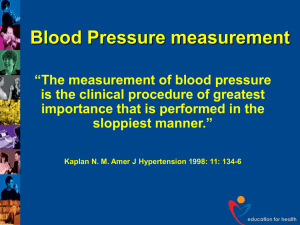Non-Invasive Blood Pressure Measurement Techniques and Issues
advertisement

Non-Invasive Blood Pressure Measurement Techniques Issues and Challenges that affect us Ausculatory and Oscillometric Ausculatory (manual or automated) uses detection of Korothoff sounds to determine blood pressure. Detection is either by a clinician’s ear using a stethoscope or a microphone inside of an automated unit. Pressure is displayed by either a dial(Aneroid) or column of mercury. Oscillometric measures the oscillations in the air contained in the machine’s umbilical cable caused by the arterial pressure pulse. The machine measures MAP then calculates systolic and diastolic pressure. This reading is usually displayed by LED's (Light Emitting Diodes) on a display. Which one is better? Oscillometric Pros and Cons Movement,muscle tremors and abnormal heart rhythms, a very weak pulse or pressure can cause some automated units to fail to obtain a reading. And most devices need a reasonably steady BP during deflation to accurately detect the appearance, maximum and disappearance of pressure oscillations. And the initial price may restrict it’s wide spread use. But they are easily transportable, very easy to use, can give multi-parameter readings (temperature, SpO2), can have a built-in paper recorder, have no observer bias and are mercury-free. And when used properly give accurate and repeatable readings. The oscillometric method does not determine the blood pressure instantaneously but it determines it from the curves of the changes in the pressure and its oscillation. This feature has anti-noise characteristics as it is not affected by external noise or electric surgical units. Even when the Korotkoff sounds are hardly detected due to hypotension, the oscillometric method is capable of determining BP because the cuff oscillates as long as the artery pulsation exists. Which one is better? Ausculatory Pros and Cons Two types of manometers are used in this facility, Aneroid and Mercury. Aneroids require annual checks to insure that mechanical wear or shocks haven’t affected readings. Mercury is the “Gold Standard” of NIBP but needs accuracy checks as well. Most of the problems with ausculatory are operator induced such as digit preference, observer bias and differences with operators in auditory acuity. But now the major problem with mercury manometers is the mercury used inside the manometers. What’s this I am hearing about getting rid of mercury? The VHA’s policy is to comply with the EPA’s Pollution Prevention Act, Resource Conservation and Recovery Act and all state and local environmental regulations in controlling and reducing elemental mercury and mercury containing compound in the health care waste stream with the goal of eliminating mercury from the health care waste stream by 50% by 2005 and eventually achieving a mercury-free environment. Locally, we are conducting an inventory to document the number and types of medical and non-medical devices containing mercury then where practical utilize mercury-free products. Also promoting awareness of the problems associated with mercury is a large part of the solution. Why do we need to do this? Mercury is found in many medical devices and uses such as thermometers, BP manometers, esophageal dilators as well as many non-medical products. If these products are broken, spilled or disposed of improperly, mercury can be released into the environment. Incinerators release mercury into the environment when waste containing mercury is burned. Hospitals contribute 4-5% of the total wastewater mercury load. There is up to 50 times more mercury in medical waste that in general municipal waste. Mercury from thermometers contribute about 17 tons of mercury in landfills annually. Even if properly recycled its reuse in new products pose the same eventual risk. Inside the hospital mercury spills are costly because of the special training, equipment and disposal required. Surely Mercury isn’t that bad! Exposure to mercury can occur three ways: inhalation, ingestion and absorption. The most likely route of inorganic mercury is through inhalation after a spill. Short term exposure to mercury vapor can cause nausea, shortness of breath, pneumonitis and bronchitis. Long term exposure can lead to personality changes, memory loss, stupor and coma. The elemental mercury used in thermometers and manometers is converted by microorganisms in the environment to methlymercury, the most toxic form. Exposure to organic mercury is through the water we drink by contamination of groundwater or by the food we eat because of contamination of the environment. Methlymercury is a neurotoxin and especially dangerous to fetuses and young children. A 2001 CDC study found that 10% of women have mercury levels high enough to cause neurological damage to their children. Wouldn’t keeping mercury out of the environment make these questions easier to answer? Is this fish mercury-free? Has mercury contaminated this lake? What do I do if I think my equipment is not working properly? The most common problems affect both ausculatory and oscillometric types. First make sure that you don’t have an external air leak either in the cuff or tubing connecting the cuff to the unit. Aging BP cuffs are the source of most air leaks [replacements are available from SPD (both single and dual tube types)]. If you suspect a mechanical or electronic problem then call the work order desk at extension 5018. The more information (type of unit , problems experienced) you can provide will speed up any repairs. What Affects A Reading? No matter which method you use there are common issues that affect both methods of measuring blood pressure. First the equipment: Is the cuff you are using sized for the patient? A cuff too large can cause reading to be lower than actual and a cuff too small can cause reading to be higher than actual. Cuff sizes are:Small Adult 17-25cm/Standard Adult 2333cm/Large Adult 31-40cm/Thigh 38-50cm. Is the equipment (either sphygmomanometer or vital signs monitor) working properly? Air leaks in the cuff, tubing or inside the unit can affect the deflation rate. An mercury or aneroid manometer that is improperly zeroed will affect the entire reading. How does the patient’s state affect the pressure reading? Is your patient ready? If your patient has finished a cigarette or an alcoholic beverage within the last 15 minutes the readings will be altered. If they haven’t sat quietly for at least 5 minutes or are talking during the procedure, the readings will be altered. And if you have placed the cuff over a shirt sleeve the readings will not be reliable. What can I do to insure an accurate reading? Follow the Hypertension guidelines for BP measurement. Daily before using any type of manometer verify that it is in good working order. And if you feel that the device you are using is not providing an accurate reading, tag the device and notify the work order desk at extension 5018. My Critikon won’t take a BP reading!! Is it the cuff OR Is it the Critikon??? Connect each one of the cuffs to the Critikon, push start and see what happens! What’s Your Rate? Deflation that is…... Inflate the cuff to 200mm/Hg Tell the timer to start the clock, then deflate the cuff at the recommended 2-3 mm/sec rate. After 20 seconds when the timer says stop, close the valve. We tell you what your rate is!









